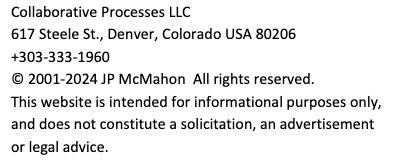 Collaborative processes
Collaborative processes
Collaborative processes® draws on the work of Collaborative Leadership Fieldbook, Chrislip, 2002, and Collaborative Leadership, Chrislip and Larson, 1991 and sees the following conditions for successful collaboration:
Motives for collaboration and initiating context
1. Good timing and clear need.
2. Convening leadership.
Organizing elements of collaboration
3. Inclusion: broad based involvement and strong stakeholder groups.
4. Constructive process; a safe environment that includes credibility, openness, flexibility, shared learning, capacity building, some interim successes, ability to overcome mistrust and skepticism, and undertake adaptive work.
5. Good information for decisions (from within or outside the group).
Critical roles that must be played in collaboration
6. Appropriate stakeholders including the commitment or involvement of high level visible leaders and support or acquiescence of established authorities or powers.
7. Process expertise to facilitate the group.
8. Substance expertise that supports group learning.
9. Facilitative leadership from among the group to promote collaboration.
Collaborative processes® works with stakeholders to create these conditions. Often the motive to collaborate in a given situation will not be the same; so the various motives must be addressed: Parties may collaborate to: achieve a better outcome, save time and money, or create engagement.

